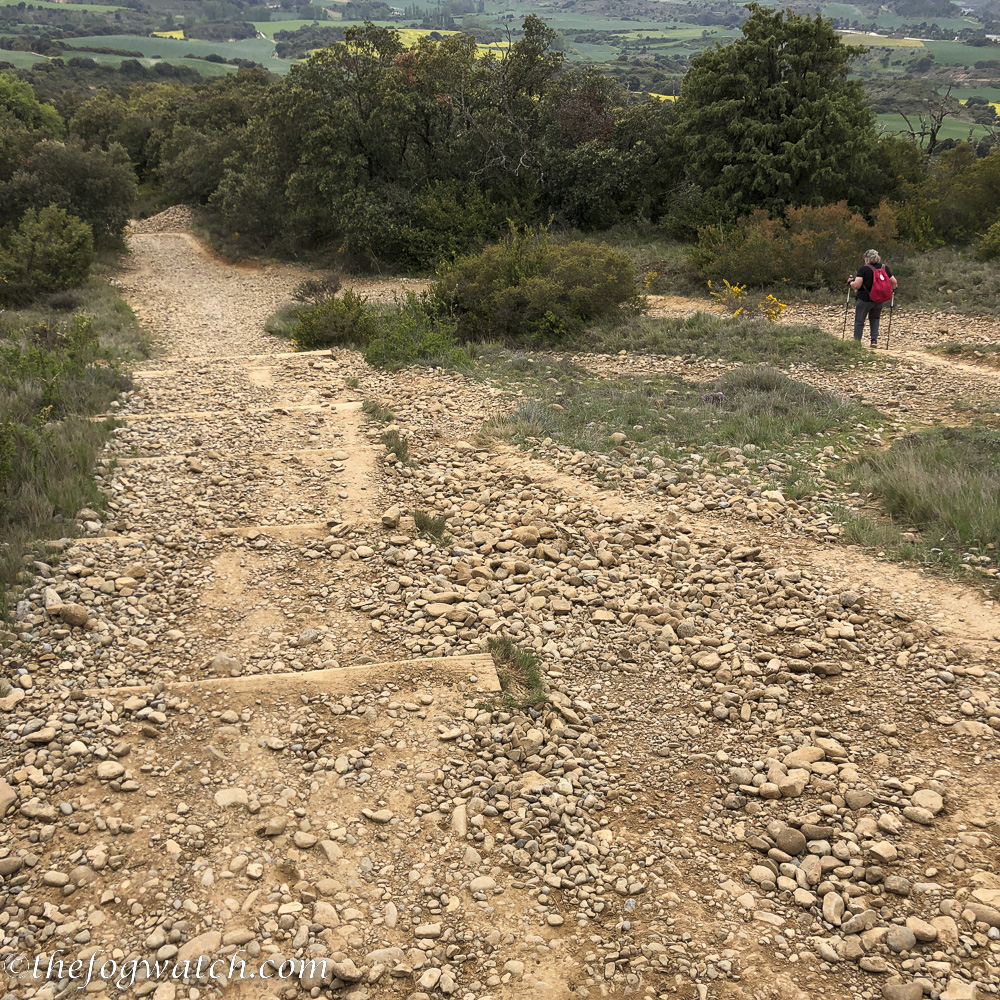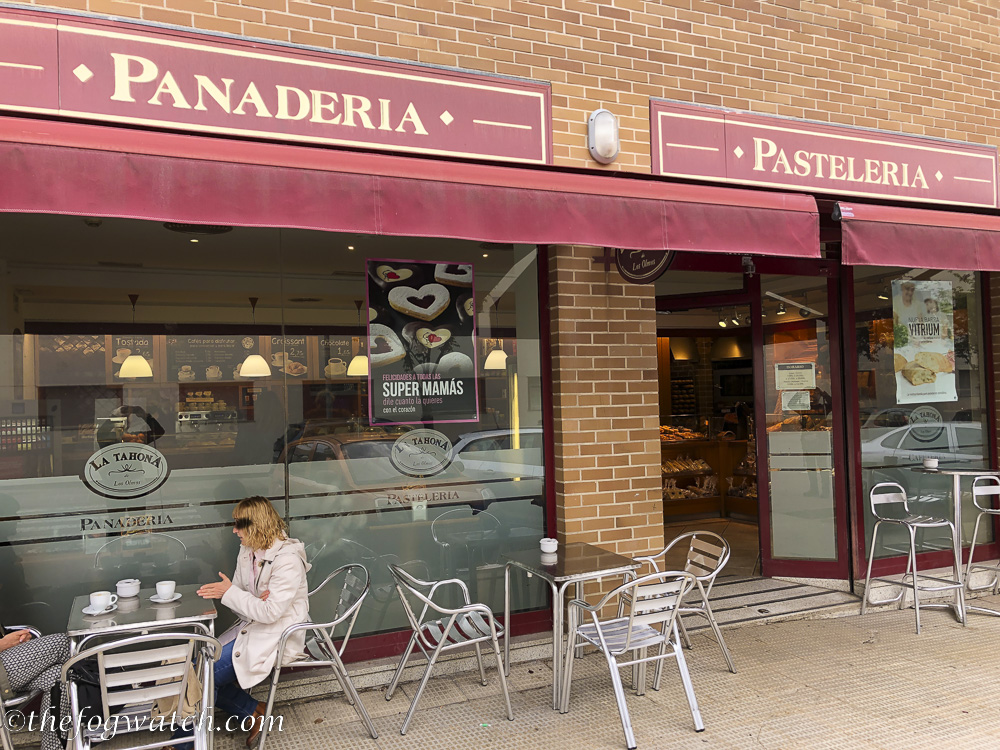With a quick last look out of our window overlooking the Town Hall square, we packed up and headed out early to the outskirts of the town, past the University of Navarre en route to Uterga. There we found a cafe/bakery and enjoyed a pot of tea and a Napolitana (chocolate croissant).

Soon we were out in the farmlands and climbing steadily towards Cezur Menor. We passed a pair of churches. The one to the left appeared the older, perhaps dating to the C12th as it has a Romanesque section with alabaster windows.
Sharon had only had a cup of tea before, so instead of continuing on the Camino track bypassing Cezur Menor, we saw a sign pointing off to a coffee shop and we diverged on a quest for breakfast. We passed through a modern estate of identical houses and modern apartments for about 500 metres before finding the cafe. Clean and modern, we satisfied ourselves with a croissant and more tea.
Then we backtracked to join the path that wound its way up towards Zariquegui. The path took us past fields of poppies and colourful canola.

On the hill, we could see what appeared to be an earthwork for an iron age hill enclosure or perhaps more likely, a medieval signal tower — a reminder of more violent times in the past.
The cafe was open, but the two Albergues were not — perhaps they haven’t opened for the season yet, or maybe they were between owners. There were no seats at the cafe either, so we grabbed an orange juice and sat on the wall opposite, alongside several other pilgrims.

The church — which featured in the movie The Way — was open so we went inside. I lit a candle and we got stamps for our credentials.
I was conscious of the time, as we still had quite a way to go to reach our destination. We resumed our climb to the landmark sculptures on the Alto del Perdon – the hill of forgiveness. The tradition goes that if you climb the Alto del Perdon and subsequently die on the Camino, then you will die in a state of grace with your sins wiped as though you had completed the pilgrimage. The hill was named for a pilgrim hostel and monastery dedicated to Nuestra Señora del Perdón (Our Lady of Atonement). The C13th monastery was destroyed by Napoleon’s troops, and a plaque marks where it once stood.

We could hear the gentle susurration of the giant windmills overhead. And we noticed that the path has been rerouted with a shorter, slightly steeper section on a well-made track. And soon the statues came into view. The metal sculpture of pilgrims through the ages is titled ‘Where the Path of the Wind Crosses that of the Stars’. It was made by Vicente Galbete. It was commissioned by the “Asociación de Amigos del Camino” of Navarre — the Navarre Friends of the Camino Association.
For me, the twelve figures represent the history of the Camino. The figures at the front are dressed in early pilgrim clothes. Then some are on horseback as wealthy pilgrims took horses and mules. And finally, perhaps, modern pilgrims as a symbol of the Camino today. The twelve is perhaps also representative of the twelve Apostles. Whatever your interpretation, they stand as iconic and powerful symbols of the journey we are undertaking. In previous Caminos, we had stayed at Zariquegui so as to get dawn photos of the sculptures, but today it was late morning, and the coffee van was there.

There is a stone circle nearby, like a mini Stonehenge, but it is actually a memorial to the 92 people from Sierra del Perdon who lost their lives during the Spanish Civil War. The large stone in the middle represents the victims, the smaller stones represent the towns and villages they came from.
A hermitage once stood here — a shelter for pilgrims. Indeed, a shelter would be useful as it is windy on good days. And if there was rain, it would drive in horizontally. The Alto de Perdon is one of the early tests on the Camino. After a long strenuous walk up the rise, it’s definitely time to rest and perhaps eat a snack and drink some water. It is said that if you make the climb to Alto de Perdon, then if you die on the road to Santiago, you will die in a state of grace with your sins forgiven. There are a few places with this story. It is a reminder that it is not an easy path, and even today, people do die on the journey.
And there is a legend:
It is in the medieval period (not a dark age) and a pilgrim awakens in the pre-dawn light, heading out from Pamplona where he has stayed the night. Wanting to get a start in the cool morning he set off on the path to climb the Alto de Perdon. In his rush to leave, he had left his gourd bottle behind and the dawn comes clear and bright. It is Summer, and the day quickly gets hotter. He struggles on the hill, perspiring heavily and the hill seemed to get steeper and steeper. Dehydrated, he starts to get desperate — surely there must be a spring or a stream somewhere. His tongue felt like sand and his throat was dry. A headache was starting and he began to wonder if he might die there on the mountain. As he rounded a corner he saw another pilgrim approaching.
“Please help me — for the love of God can you spare me some water?”
“Of course,” said the other pilgrim “happy to help, but I must ask you something in return”
“Then just ask,” said the first
“Renounce your faith in God”
“Never!”
“Then renounce your veneration of the Virgin Mary”
“Never!”
Then at least renounce your trust in Saint James the Apostle”
That I will never do — you must be the devil himself!”
“Ah you’ve found me out, and so I must leave you here to die of thirst in this forsaken place, and you will never reach Santiago de Compostella” And with that, he vanished.
The pilgrim stumbled and sank to his knees, and prepared himself to die.
Soon another pilgrim approached, took him in his arms, and carried him to a hidden Spring, where he gave the pilgrim water with his own scallop shell. The pilgrim coughed and drank gratefully, gradually reviving in the shade of a tree. Then he heard the other pilgrim say:
“Because you haven’t renounced your faith in God, nor your veneration for Our Lady, nor even your trust in me, continue your pilgrimage safely to Compostela!”
The pilgrim opened his eyes to thank his benefactor, but he was alone. Revived, he continued his journey safely to Compostela, and gave thanks.
For us, St James in this story took the form of a coffee van just across from the statues, offering orange juice and coffee and, of course, bottles of water. Suitably refreshed, we made our way to the descending path.
The Stoic philosopher, Epictetus reminds us that for every challenge you face, you have the inner resources to deal with it. Marcus Aurelius describes this as the ‘Inner citadel’ of the mind.
“Remember that your directing mind becomes invincible when it withdraws into its own self-sufficiency … a mind free from passions is a fortress (or citadel) — people have no stronger place of retreat, and someone taking refuge there is then impregnable.”
[Marcus Aurelius, Meditations Book 8:48]
Often when we feel we are at the end of our tether, we reach inward to find our resilience. Sometimes we reach out to a virtual Other (perhaps with prayer) to find that extra strength within ourselves.
The journey along the Camino de Santiago is one filled with physical and spiritual challenges. These can help to bring out our inner strength. As we struggle to reach Uterga, we can use Stoic ideas to help us recognize our own potential and appreciate the beauty around us, find peace in moments of difficulty. And we can take comfort in knowing that life’s struggles are just temporary — as is this difficult descent.

This was the hard part, much more difficult than the climb. The loose gravel is like walking down a staircase strewn with marbles and Lego bricks. Several times our trekking poles saved us from a nasty fall. The day was overcast and quite humid, and yes, we carried enough water. The path was stepped and covered with round stones that moved underfoot perfectly designed to twist an ankle or cause a fall. If you are unsteady, consider getting a taxi from the Alto del Perdon or Zariquegui. Or at least send your pack ahead on that day.
At length, the path started to level out and soon we passed a monument to a fallen pilgrim, and a statue dedicated to the Virgin Mary, alongside a potable water font.

The statue is known as the Virgin of Irunbidea.
The story goes that an exhausted pilgrim from Madrid came by and sat down next to the fountain, his energy completely drained. A six-year-old girl came up to him, and he asked her name. ‘Mary’ came the response. On hearing the name, he prayed for strength and solace, and soon found the energy to continue on his pilgrimage. Thus inspired, he later returned to the village and donated this statue of the Virgin Mary. The statue was erected in August 2002.
Again, the pilgrim in the story reached outward to find inner strength — it is a common tale. And perhaps unsurprisingly so, as this difficult descent is enough to tax the strength of all but the strongest and most gazelle-like of pilgrims.
We rested by the fountain and replenished our water bottles. Thus restored, we set off through the farmlands to reach Uterga — our destination for the night.








As always, an inspiration, even in daily life.
Thank you 🙂